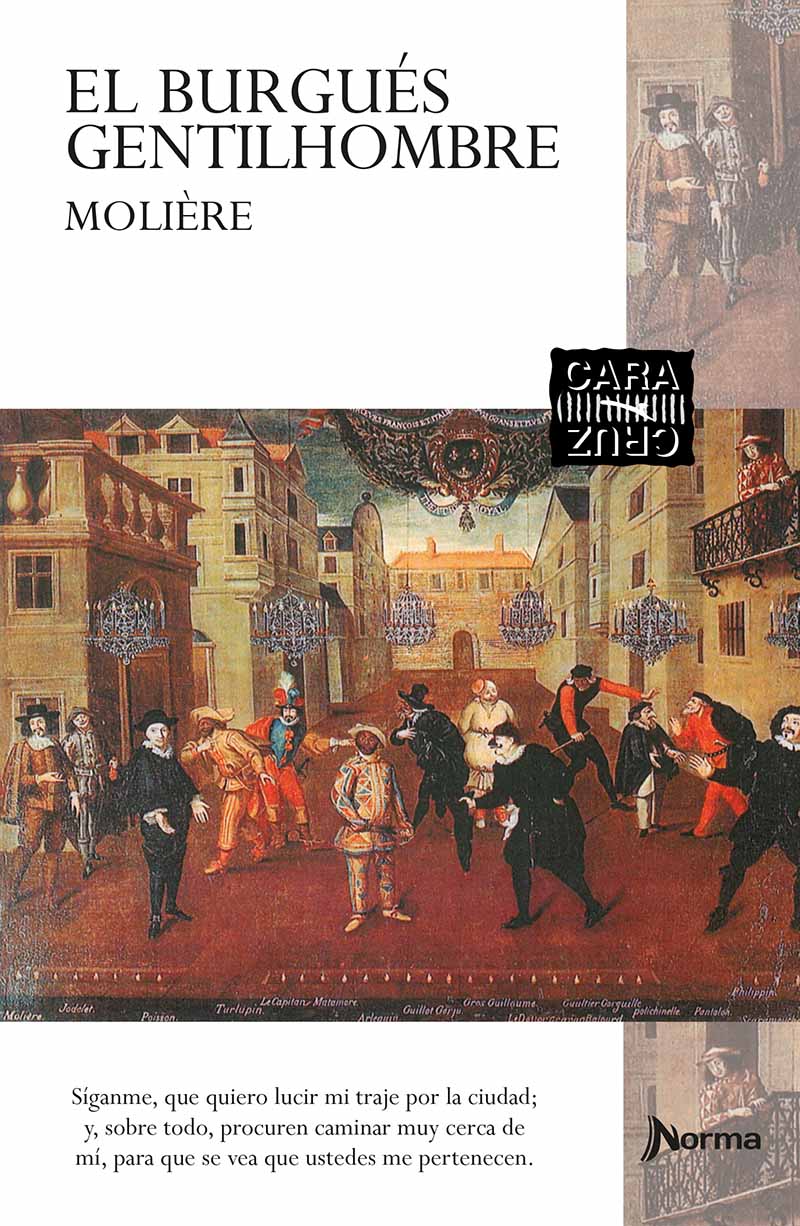
El burgués gentilhombre es una comedia-ballet de Molière en cinco actos y en prosa, estrenada por la compañía de Molière el 14 de octubre de 1670 en la corte de Luis XIV en el Castillo de Chambord. La música es de Jean-Baptiste Lully, la coreografía de Pierre Beauchamp y los decorados de Carlo Vigarani. Monsieur Jourdain es un hombre de 40 años, bastante ridículo debido a su frialdad e ingenuidad. Su padre se había enriquecido con su oficio de zapatero, de modo que le pudo dar la condición de burgués. Éste pretende adquirir los modales de los aristócratas que frecuentan la corte, para así llegar él a ser un hombre distinguido, noble y de alto rango como sus ídolos. Invita a gente distinguida, dioses para él, a cenar en su casa, dándoles grandes banquetes y favores con la esperanza de que le den a cambio algún reconocimiento, lo cual sería un inmenso honor para él. También se dedica a aprender todo aquello que le parece indispensable: el manejo de las armas, el baile, la música, la filosofía, etc.; pero sin interesarle de veras, sino únicamente para imitar lo mejor posible a un elegante y distinguido noble. Debido a esto, sus maestros hablan desdeñosamente de este «nuevo e ignorante burgués que no aprecia el arte», pero que al menos entrega una generosa remuneración.
Author

Jean-Baptiste Poquelin, also known by his stage name, Molière, was a French playwright and actor who is considered one of the greatest masters of comedy in Western literature. Among Molière's best-known dramas are Le Misanthrope, (The Misanthrope), L'Ecole des femmes (The School for Wives), Tartuffe ou l'Imposteur, (Tartuffe or the Hypocrite), L'Avare ou l'École du mensonge (The Miser), Le Malade imaginaire (The Imaginary Invalid), and Le Bourgeois Gentilhomme (The Bourgeois Gentleman). From a prosperous family and having studied at the Jesuit Clermont College (now Lycée Louis-le-Grand), Molière was well suited to begin a life in the theatre. Thirteen years as an itinerant actor helped to polish his comic abilities while he also began writing, combining Commedia dell'Arte elements with the more refined French comedy. Through the patronage of a few aristocrats including the brother of Louis XIV, Molière procured a command performance before the King at the Louvre. Performing a classic play by Pierre Corneille and a farce of his own, Le Docteur amoureux (The Doctor in Love), Molière was granted the use of Salle du Petit-Bourbon at the Louvre, a spacious room appointed for theatrical performances. Later, Molière was granted the use of the Palais-Royal. In both locations he found success among the Parisians with plays such as Les Précieuses ridicules (The Affected Ladies), L'École des maris (The School for Husbands) and L'École des femmes (The School for Wives). This royal favour brought a royal pension to his troupe and the title "Troupe du Roi" (The King's Troupe). Molière continued as the official author of court entertainments. Though he received the adulation of the court and Parisians, Molière's satires attracted criticisms from moralists and the Church. Tartuffe ou l'Imposteur (Tartuffe or the Hypocrite) and its attack on religious hypocrisy roundly received condemnations from the Church while Don Juan was banned from performance. Molière's hard work in so many theatrical capacities began to take its toll on his health and, by 1667, he was forced to take a break from the stage. In 1673, during a production of his final play, Le Malade imaginaire (The Imaginary Invalid), Molière, who suffered from pulmonary tuberculosis, was seized by a coughing fit and a haemorrhage while playing the hypochondriac Argan. He finished the performance but collapsed again soon after, and died a few hours later. In his time in Paris, Molière had completely reformed French comedy.